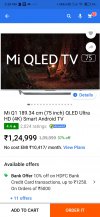I have mentioned this a few times earlier. If you can, borrow a HDMI 2.0 or 2.1 cable and check for reliability with ARC. Even the cheapest cable will do. Just a reputed manufacturer or make. I use a legacy receiver too which goes up to HDMI 1.4 only and its connected to a HDMI 2.0 TV. I could not get ARC to work at all. Some have said it works and the audio stutters. In my case, no audio at all. All I did was buy a new HDMI 2.0 cable and the problem vanished as soon as I plugged it in. I did not do anything else. Like some others who reported, I did not know what HDMI cable version I was using earlier. It was just some cable that I had and was using for the last 4 years, reliably with my Samsung htib. Arc worked without a hitch.
HDMI as is, has been dodgy from day one. Its a combination of all the software and hardware version and releases that complicates things. Not to forget, all the licensing agreements one has to pay for it to work.
Ignore the pixelation for SD content. That is how it will be. No TV can magically correct that. You may actually see pixellation with HD content too owing to the size of the screen. I can see grain and pixellation even on a 55" TV with streaming content. Even the best of TV's have this and can be corrected only with external software processing. Yes; poor upscaling can cause that problem. I tend not to bother upscaling as it only ruins the image.
Your TV is rated at 120 Mhz, artificially enhanced refresh rate. Its basically frame insertion. The manufacturer does not publish the native refresh rate and I doubt if its higher than 60hz considering the cost of the TV. Depending on what you are watching, you will experience some or very poor motion handling. The only way to know the true capability of the TV's motion handling is to feed a Blu Ray disc. I don't use motion smoothing even on my Sony, which is pretty well implemented. Its weird looking and that film motion looks artificial. Some folks like it, more for bragging rights on making the TV look good. In my view, its all marketing nonsense. Very few TV's get this right and if you want the ultimate, the TV must do 100 or 120hz native refresh rate (Not via software).
For the misinformed, folks who make their judgement on a product based on theoretical benchmarks such as nit rating, dxomark, etc and all that nonsense, you need to take all of that with a grain of salt. To clear the air, I work in visual effects. We use nothing less than the best cameras, lenses, projectors and TV's. For us, none of these ratings matter. It is a mere guide for a product. All we care about is if a display is color accurate and if it can be calibrated. In this space, there are only 6 names that come up. Eizo, LG, Panasonic, JVC, HP Dreamcolor and Sony. We used Pioneer Kuro's back in the day as they were the best. Then we moved to Panasonic and now we are on LG C1's. The LG's are the best to date and have been consistent in their panels for the last 4 years. By the way, we can't reliably calibrate even a TV like this. Its a hit or miss. Once we do calibrate, they stay on and are never switched off as if you do, you lose the calibration settings. They are left on always, even if no content is playing on them. At the most, if we care lucky, we may get 26,000 hours of reliable screen life. That is about 3 years of not turning of the TV post which the panel just burns out and we get washed colors. This is no good for us. For someone to tell me that the TV being discussed here is the best of its kind, you must be joking. If that's what you can afford, I can understand. We all have our budgets. Personally; I cannot buy a TV like this. One that is unproven in the field. That too from a manufacturer who's is relatively unknown in the space of building TV's. If the product was so good, the whole world will be buying it. What I see here is a purchase primarily for its low price and screen real estate. It means nothing to me. I will be content and happy with a smaller screen that is proven to perform better. Not a blind buy or based on some random internet review. You don't buy a TV for the short term. You buy one that will be consistent in its performance and you want some kind of manufacturer support well beyond the warranty. I can guarantee that will be non existent with this brand. If 75" is the TV you want and this is the only TV you can afford, go ahead and buy one. All I ask is look at what else you can buy for similar money and lesser screen real estate from some of the known names in TV. You won't regret it. Its your hard earned money. Don't throw it away like that.



